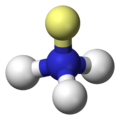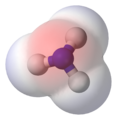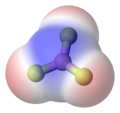- Chemical polarity
-
- "Polar molecule" and "Nonpolar" redirect here. For other uses see Polar (disambiguation).
In chemistry, polarity refers to a separation of electric charge leading to a molecule or its chemical groups having an electric dipole or multipole moment. Polar molecules interact through dipole–dipole intermolecular forces and hydrogen bonds. Molecular polarity is dependent on the difference in electronegativity between atoms in a compound and the asymmetry of the compound's structure. For example, a molecule of water is polar because of the unequal sharing of its electrons between oxygen and hydrogen in which the former has larger electronegativity than the latter, resulting in a "bent" structure, whereas methane is considered nonpolar because the carbon shares the electrons with the hydrogen atoms almost uniformly. Polarity underlies a number of physical properties including surface tension, solubility, and melting- and boiling-points.
Contents
Theory
Electrons are not always shared equally between two bonding atoms; one atom might exert more of a force on the electron cloud than the other. This "pull" is termed electronegativity and measures the attraction for electrons a particular atom has. The unequal sharing of electrons within a bond leads to the formation of an electric dipole: a separation of positive and negative electric charge. Partial charges are denoted as δ+ (delta plus) and δ− (delta minus). These symbols were introduced by Christopher Ingold and his wife Dr. Hilda Usherwood in 1926.[1]
Atoms with high electronegativities — such as fluorine, oxygen, and nitrogen — exert a greater pull on electrons than atoms with lower electronegativities. In a bond, this can lead to unequal sharing of electrons between atoms, as electrons will be drawn closer to the atom with the higher electronegativity.
Bonds can fall between one of two extremes — being completely nonpolar or completely polar. A completely nonpolar bond occurs when the electronegativities are identical and therefore possess a difference of zero. A completely polar bond is more correctly termed ionic bonding and occurs when the difference between electronegativities is large enough that one atom takes an electron from the other. The terms "polar" and "nonpolar" bonds usually refer to covalent bonds. To determine the polarity of a covalent bond using numerical means, the difference between the electronegativity of the atoms is taken. If the result is between 0.4 and 1.7 then, generally, the bond is polar covalent.
Polarity of molecules
While the molecules can be described as "polar covalent", "nonpolar covalent", or "ionic", it must be noted that this is often a relative term, with one molecule simply being more polar or more nonpolar than another. However, the following properties are typical of such molecules.
A molecule is composed of one or more chemical bonds between molecular orbitals of different atoms. A molecule may be polar either as a result of polar bonds due to differences in electronegativity as described above, or as a result of an asymmetric arrangement of nonpolar covalent bonds and non-bonding pairs of electrons known as a full molecular orbital.
Polar molecules
Examples of common household polar molecules include sugar, for instance the sucrose sugar variety. Sugars have many polar oxygen–hydrogen (-OH) groups and are overall highly polar.
Due to the polar nature of the water molecule (H2O) itself, polar molecules are generally able to dissolve in water.
-
Sucrose, a sugar, has many polar -OH groups
- Example 1. The hydrogen fluoride, HF, molecule is polar by virtue of polar covalent bonds — in the covalent bond electrons are displaced towards the more electronegative fluorine atom.
- Example 2. In the ammonia, NH3, molecule the three N–H bonds have only a slight polarity (toward the more electronegative nitrogen atom). However, the molecule has two lone electrons in an orbital, that points towards the fourth apex of the approximate tetrahedron, (VSEPR). This orbital is not participating in covalent bonding; it is electron-rich, which results in a powerful dipole across the whole ammonia molecule.
- Example 2.5. In the ozone, O3, molecule the two O–O bonds are nonpolar (there is no electronegativity difference between atoms of the same element). However, the distribution of other electrons is uneven — since the central atom has to share electrons with two other atoms, but each of the outer atoms has to share electrons with only one other atom, the central atom is more deprived of electrons than the others (the central atom has a formal charge of +1, while the outer atoms each have a formal charge of −1/2). Since the molecule has a bent geometry, the result is a dipole across the whole ozone molecule.
-
Hydrogen fluoride: the more electronegative fluoride atom is shown in yellow
-
Ammonia: the two lone electrons are shown in yellow, the hydrogen atoms in white
Nonpolar molecules
 Diagram showing the net effect of symmetrical polar bonds (direction of yellow arrows show the migration of electrons) within boron trifluoride cancelling out to give a net polarity of zero. δ- shows an increase in negative charge and δ+ shows an increase in positive charge.
Diagram showing the net effect of symmetrical polar bonds (direction of yellow arrows show the migration of electrons) within boron trifluoride cancelling out to give a net polarity of zero. δ- shows an increase in negative charge and δ+ shows an increase in positive charge.A molecule may be nonpolar either because there is (almost) no polarity in the bonds (when there is an equal sharing of electrons between two different atoms) or because of the symmetrical arrangement of polar bonds.
Examples of household nonpolar compounds include fats, oil, and petrol/gasoline. Therefore (per the "oil and water" rule of thumb), most nonpolar molecules are water-insoluble (hydrophobic) at room temperature. However, many nonpolar organic solvents, such as turpentine, are able to dissolve polar substances. When comparing a polar and nonpolar molecule with similar molar masses, the polar molecule in general has a higher boiling point, because of the dipole–dipole interaction between their molecules. The most common form of such an interaction is the hydrogen bond, which is also known as the H-bond.
- Example 3. In the methane molecule (CH4) the four C–H bonds are arranged tetrahedrally around the carbon atom. Each bond has polarity (though not very strong). However, the bonds are arranged symmetrically so there is no overall dipole in the molecule.
- Example 4. The boron trifluoride molecule (BF3) has a trigonal planar arrangement of three polar bonds at 120°. This results in no overall dipole in the molecule.
- Example 5. The oxygen molecule (O2) does not have polarity in the covalent bond because of equal electronegativity, hence there is no polarity in the molecule.
-
Methane: the bonds are arranged symmetrically so there is no overall dipole
-
Boron trifluoride: trigonal planar arrangement of three polar bonds results in no overall dipole
Hybrids
Large molecules that have one end with polar groups attached and another end with non polar groups are good surfactants. They can aid in the formation of stable emulsions, or blends, of water and fats. Surfactants reduce the inter facial tension between oil and water by adsorbing at the liquid–liquid interface.
-
This complex molecule has several polar groups (hydrophilic, water-loving) on the right side and a long nonpolar chain (lipophilic, fat-loving) at the left side. This gives it surfactant properties
-
A micelle — the lipophilic ends of the surfactant molecules dissolve in the oil, while the hydrophilic charged ends remain outside in the water phase, shielding the rest of the hydrophobic micelle. In this way, the small oil droplet becomes water-soluble.
-
Phospholipids are effective natural surfactants that have important biological functions
-
Cross section view of the structures that can be formed by phospholipids. They can form a micelle and are a vital in forming cell membranes
Predicting molecule polarity
- This classification table gives a good general understanding of predicting molecular dipole of some general molecular structures. However, one should not interpret it literally:
Formula Description Example Polar AB Linear Molecules CO HAx Molecules with a single H HF AxOH Molecules with an OH at one end C2H5OH OxAy Molecules with an O at one end H2O NxAy Molecules with an N at one end NH3 Nonpolar A2 Diatomic molecules of the same element O2 CxAy Most carbon compounds CO2 - Determining the point group is a useful way to predict polarity of a molecule. In general, a molecule will not possess dipole moment, if the individual bond dipole moments of the molecule cancel each other out. This is because dipole moments are euclidean vector quantities with magnitude and direction, and a two equal vectors who oppose each other will cancel out.
Any molecule with an centre of inversion ( "i" ) or a horizontal mirror plane ( "σh ") will not possess dipole moments. Likewise, a molecule with more than one Cn axis will not possess dipole moment because dipole moments cannot lie in more than one dimension. As a consequence of that constraint, all molecules with D symmetry (Schönflies notation) will, therefore, not have dipole moment because, by definition, D point groups have two or multiple Cn axis.
Since C1, Cs,C∞h Cn and Cnv point groups do not have a centre of inversion, horizontal mirror planes or multiple Cn axis, molecules in one of those point groups will have dipole moment.
See also
- Bond dipole moment
- Solubility
- Colloid
- Detergent
- Dipole
- Covalent bond
- Electronegativity
- Dielectric
- Chemical bonding
References
Articles related to solutions Solution Ideal solution · Aqueous solution · Solid solution · Buffer solution · Flory-Huggins · Mixture · Suspension · Colloid · Phase diagram · Eutectic point · Alloy · Saturation · Supersaturation · Serial dilution · Dilution (equation) · Apparent molar propertyConcentration
and related quantitiesMolar concentration · Mass concentration · Number concentration · Volume concentration · Normality · Percentage solution · Molality · Mole fraction · Mass fraction · Mixing ratioSolubility Solubility equilibrium · Total dissolved solids · Solvation · Solvation shell · Enthalpy of solution · Lattice energy · Raoult's law · Henry's law · Solubility table (data) · Solubility chartSolvent (category) · Acid dissociation constant · Protic solvent · Inorganic nonaqueous solvent · Solvation · List of boiling and freezing information of solvents
Partition coefficient · Polarity · Hydrophobe · Hydrophile · Lipophilic · AmphiphileChemical bonds Intramolecular
("strong")Sigma bond · Pi bond · Delta bond
Double bond · Triple bond · Quadruple bond · Quintuple bond · Sextuple bond
3c–2e · 3c–4e · 4c–2e
Agostic bond · Bent bond · Dipolar bond · Pi backbond
Conjugation · Hyperconjugation · Aromaticity · Hapticity · AntibondingCation–pi bond · Salt bondIntermolecular
("weak")Other noncovalentvan der Waals force · London dispersion force · Mechanical bond · Halogen bond · Aurophilicity · Intercalation · Stacking · Entropic force · Chemical polarityNote: the weakest strong bonds are not necessarily stronger than the strongest weak bondsCategories:- Chemical bonding
- Physical chemistry
- Chemical properties
Wikimedia Foundation. 2010.













